The OnePlus 7 Pro Review: Outstanding Performance & Screen, Adequate Everything Else
by Andrei Frumusanu on June 19, 2019 12:00 PM EST- Posted in
- Mobile
- Smartphones
- OnePlus
- OnePlus 7 Pro
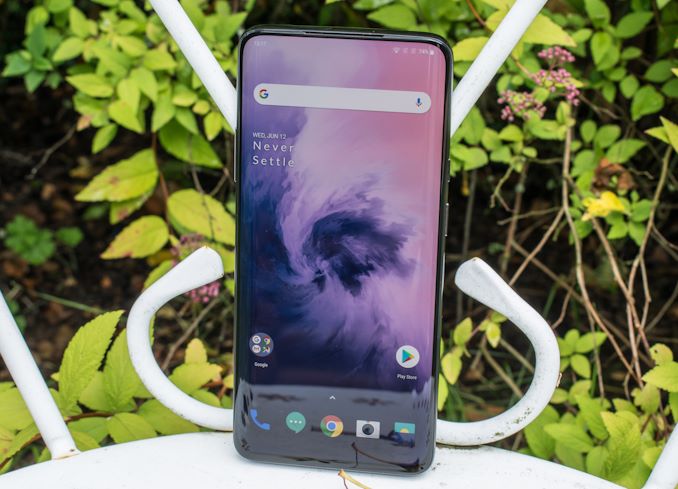
It’s been a month since OnePlus released their new flagship devices for 2019: The OnePlus 7 and OnePlus 7 Pro. The phone is one of the most awaited devices of the year and with the OnePlus 7 Pro, the company is promising to deliver a significantly better “ultra-high-end” device than ever before. Indeed over the last few years OnePlus has evolved from being a niche brand to actually being one of the most recognized smartphone vendors. With the increased popularity and product maturity, prices have also gone up, and the new OP7Pro carves itself into a higher tier device segment. Still, OnePlus’ product mantra remains unchanged and the new phone promises to deliver outstanding value for the price, being nick-named the “Flagship Killer”.
Today we review the OnePlus 7 Pro in depth, and investigate the device’s outstanding performance, the new unique 90Hz 1440p OLED display, and OnePlus’ take on a new triple-camera setup and implementation of a 48MP sensor. Naturally, we also have to talk about the phone’s new design – characterised by the new full-screen bezel-less display and pop-up front camera.
Let’s start with the fundamental specifications of the phone:
| OnePlus 7 Series | ||||||
| OnePlus 7 | OnePlus 7 Pro (Reviewed) |
|||||
| SoC | Qualcomm Snapdragon 855 1x Kryo 485 (Cortex-A76) @ 2.84GHz 3x Kryo 485 (Cortex-A76) @ 2.42GHz 4x Kryo 485 (Cortex-A55) @ 1.80GHz Adreno 640 @ 585MHz |
|||||
| DRAM | 6 / 8 GB LPDDR4X | 6 / 8 / 12 GB LPDDR4X | ||||
| Storage | 128 / 256GB UFS 3.0 | |||||
| Display | 6.41" AMOLED 2340 x 1080 (19.5:9) 60Hz |
6.67" AMOLED 3120 x 1440 (19.5:9) 90Hz |
||||
| Size | Height | 157.7 mm | 162.6 mm | |||
| Width | 74.4 mm | 75.9 mm | ||||
| Depth | 8.2 mm | 8.8 mm | ||||
| Weight | 182 grams | 206 grams | ||||
| Battery Capacity | 3700mAh 20W Charging (5V/4A) |
4000mAh Typical 3880mAh Rated 30W Charging (5V/6A) |
||||
| Wireless Charging | - | |||||
| Rear Cameras | ||||||
| Main | 48MP IMX586 0.8µm pixels (1.6µm 4:1 12MP binning) f/1.7 / f/1.6 (Pro) lens OIS |
|||||
| Telephoto | - | 13MP 1.0µm pixels (8MP 3x zoom photos) f/2.4 2.2x zoom OIS |
||||
| Wide | - | 16MP f/2.4 117° wide-angle |
||||
| Extra | 5MP 1.12µm f/2.4 Depth Sensor |
Laser-autofocus module | ||||
| Front Camera | 16MP 1.0µm IMX471 f/2.0 lens; fixed focus |
|||||
| I/O | USB-C 3.1 no headphone jack |
|||||
| Wireless (local) | 802.11ac Wave 2 Wi-Fi Bluetooth 5.0 LE + NFC Dual Band GPS (L1+L5), Dual Band Galileo (E1+E5a) |
|||||
| Cellular | UE Category 16 (DL) / Category 13 (UL) 1000 Mbit/s DL (5xCA 4x4 MIMO) 150 Mbit/s UL |
|||||
| Other Features | Dual Stereo Speakers | |||||
| Dual-SIM | Dual nanoSIM | |||||
| Colours | Mirror Gray Red (China & India) |
Mirror Gray (Glossy) Almond (Glossy) Nebula Blue (Etched/matte) |
||||
| Launch Price | 6 + 128: | £499 €575 |
6 + 128: | $669 £649 €749 ₹48,999 |
||
| 8 + 256: | £549 €639 |
8 + 256: | $699 £699 €805 ₹52,999 |
|||
| OnePlus 7 (non-Pro) Not available in US |
12 + 256: | $799 £799 €920 ₹57,999 |
||||
As is expected of a 2019 flagship, the new OP7Pro is fitted with Qualcomm’s newest Snapdragon 855 chipset, which by now should be no mystery to anyone as we’ve extensively covered the new 7nm SoC in our review of the Galaxy S10 a few months back. The new Cortex A76 derived CPU cores, the new Adreno 640 and the manufacturing process make the S855 the currently strongest Android SoC on the market.
Where OnePlus can differentiate itself is in the thermal design of the phone, and as we’ll see later in our sustained GPU performance tests, the 7 Pro fully delivers on its promises and the new heat-pipe and carbon thermal dissipation layers result in seemingly outstanding gaming performance.
The chipset is accompanied by varying amount of DRAM: OnePlus segments the capacity along with the NAND storage configuration options, starting at 6GB for the base modem, 8GB for the mid-tier, and also a 12GB ultra-high tier variant.
In terms of storage, OnePlus hit it out of the park this generation as the new 7 Pro is the first and currently only smartphone to ship with a new generation UFS 3.0 storage module. Compared to previous generation UFS 2.1 devices, this promises a doubling of the theoretical peak bandwidth, something that is noticeable especially when installing large applications.
Moving onto the design of the phone, the first thing you notice when you have the device in hand is that it’s a notably bigger phone than the OnePlus 6/6T. The 7 Pro is bigger in all dimensions; it’s wider, taller, thicker and heavier.
The back of the phone features a relatively similar design as the 6T: A centred vertical camera layout with a flash underneath it as well as the classical OnePlus logo. The back is still glass; the review unit pictured above is the “Mirror Gray” version which has an interesting holographic effect reflecting off of it. Personally I had found the chemically etched “Nebula Blue” variant a lot more interesting, if not for the colour, then because of the matte finish providing a much different feel to the phone and also not being nearly as big of a finger-print magnet as the glossy variants.
On the front of the phone we find the centre-piece and prime feature of the OnePlus 7 Pro: its bezel-less full-screen OLED display.
OnePlus isn’t the first vendor to come with such a bezel-less design to market, as we’ve seen implementations from Oppo, Honor and Xiaomi over the last ~8 months. How the OnePlus 7 Pro differs from the competition is that it offers the most refined solution to date, with the inarguably best display panel specifications in the market.
OnePlus relied on Samsung to source the screen, and it’s said that OnePlus spared no expenses this time around. The screen is a 6.67” diagonal unit at 1440p, with an exact resolution of 3120 x 1440, resulting in a wide 19.5:9 aspect ratio.
While that by itself isn’t very unusual, what is special about the phone is that this is the first 90Hz display with aforementioned specifications. The new high refresh rate display panel of the phone is very much the killer feature of the OnePlus 7 Pro, and it doesn’t disappoint. To top things off, the panel also checks all the boxes with support for HDR10+, various accurate display profiles, and promise of high brightness. The latter point is something we weren’t quite able to verify, something we’ll dwell deeper into during the display testing section.
Underneath the front screen and hidden from view is a new generation optical under-screen fingerprint sensor. The new unit is a lot faster than what we saw on the 6T as it’s very much faster than Samsung’s ultra-sonic fingerprint sensor in the S10.
OnePlus was able to achieve a bezel-less display design thanks to the phone’s new pop-up front camera module. The module itself is a 16MP IMX471 sensor with an f/2.0 lens and it takes adequately good pictures. The module is located in a “tray” that is mechanically actuated up and down by an internal motor and screw assembly. The module pops up quite fast and equally retracts at the same speed. OnePlus also implemented a fall-detection mechanism that automatically retracts the module when sensing that the phone is in free-fall, although it’s not quite fast enough to quite retract itself fully from a standing chest-height.
I have relatively mixed feelings about the design. On one hand I absolutely agree that the bezel-less screen is a definitely a winning factor of the phone, however there’s still large compromises in mechanical camera assemblies such as on the 7 Pro.
For one I found that the module more than once had retracted with some dust or debris. This didn’t result in any scratches, but I do have to wonder how the internals will look like after a year or more of usage. Also I think that this mechanism had a quite big cost in terms of actual internal space of the phone. It takes up a significant amount of volume inside the phone, plus it adds in quite a lot of weight to the phone. OnePlus 7 Pro not only is a big phone, but at 206g it’s also quite heavier than most other devices. In fact the phone that is most comparable to it in my opinion is the iPhone XS Max, which is also quite the massive unit.
The most odd and annoying thing about the pop-up camera however is the top cover of the module. Here the finish and colour just doesn’t match those of the rest of the aluminium frame of the phone. I immediately noticed this at the launch event and it seems it affects all phones in all colour variants.
Going back to the rear of the phone, another key feature of the OnePlus 7 Pro is its triple-camera setup. Like many other vendors this year, OnePlus has opted to go for Sony’s new IMX586 camera sensor for the main module. The sensor is characterised by its 48MP resolution and ability for 4:1 pixel binning into 12MP. The actual sensor’s colour filter is a quad-bayer setup, meaning the real chromatic spatial resolution is 12MP anyway, and the 48MP mode is enabled via pre-processing on the sensor itself, really only achieving chromatic spatial resolution equivalent to about ~27MP. OnePlus here does things better than a lot of other vendors; the 48MP simply isn’t available outside of the Pro mode, and I suggest users to just avoid using it at all.
OnePlus did strive to improve the optics of the new module. It comes with a f/1.6 aperture and features OIS, the latter which is quite crucial for video recording. The camera is augmented by a laser auto-focus module, as the sensor only makes use of limited phase-detect autofocus pixels.
While the new main sensor is new, the bigger addition to the camera experience of the 7 Pro is the inclusion of a wide-angle and dedicated telephoto module. The wide-angle is a 16MP unit with a 117° field of view and f/2.4 aperture optics, in line with what we’ve seen from other flagships.
The telephoto module features an effective 3x zoom (74mm equivalent focal length) at 8MP. It’s to be noted that OnePlus later clarified that the actual sensor is a 13MP unit and the optical zoom is only 2.2x, OnePlus crops this down to 8MP for an effective 3x relative to the main sensor. The full 13MP of the module are only used in portrait mode shots.
Finally, the OnePlus 7 Pro continues OnePlus’ track of not having a headphone jack. Unlike the 6T last year (And the OnePlus 7 this year), at least the 7 Pro makes use of the space by putting the SIM tray in its place at the bottom of the phone. However what’s puzzling is that OnePlus didn’t include a 3.5mm headphone dongle in the 7 Pro package. I find this relatively egregious given that consumers updating to the 7 Pro will have to purchase a unit separately. To top this off, OnePlus also doesn’t offer any bundled headphones with the phone.
The positive things in the audio department is that the speakers of the OP7Pro are significantly improved. OnePlus has significantly widened and increased the size of the earpiece grill, and the module now serves as a second speaker for stereo playback. While the audio is much improved over previous OP devices (which had terrible speakers), it doesn’t quite match the quality seen in the competition.
Overall design wise, I think the OP7Pro is a great phone with great ergonomics. I just have to remind readers that this is a big phone that is also quite heavy – so there will definitely be people who may be put off from the device due to its dimensions.


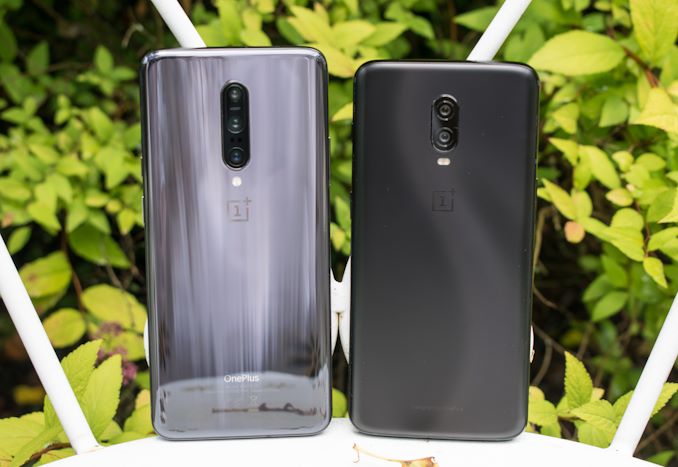
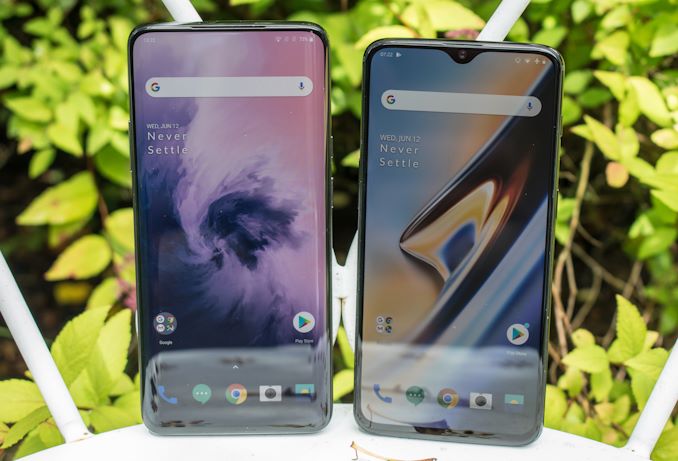

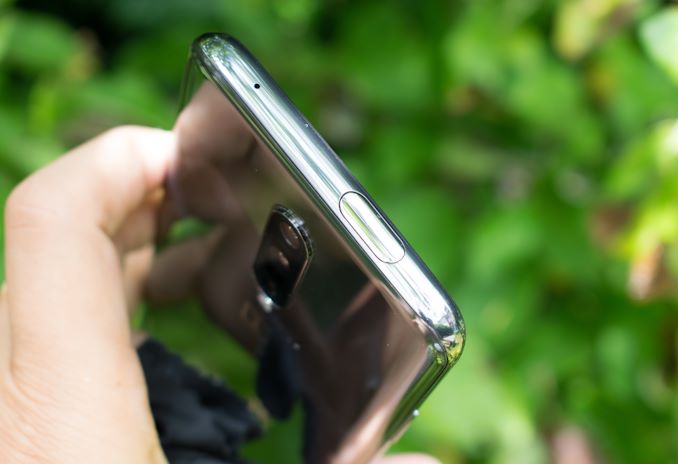
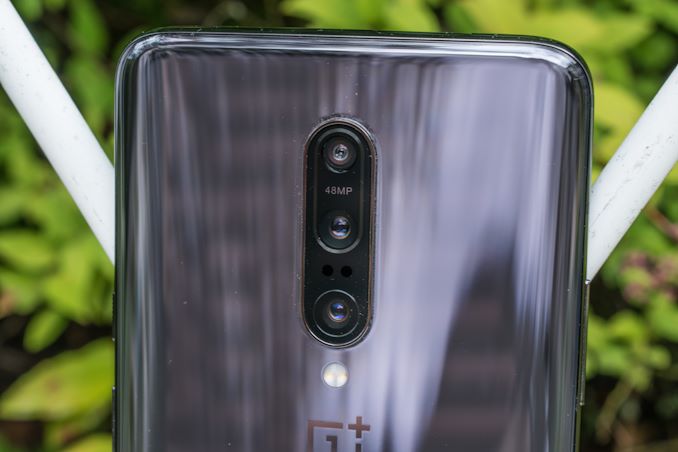
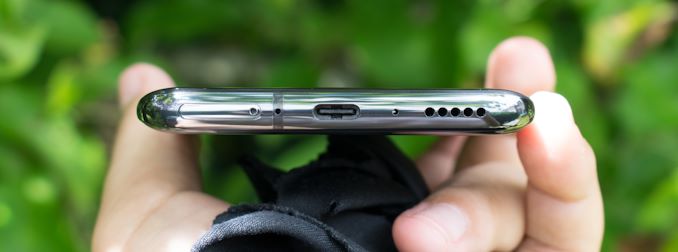








91 Comments
View All Comments
DillholeMcRib - Wednesday, June 19, 2019 - link
Can I flash this damn thing and run WIndows ARM on it?Jez1 - Wednesday, June 19, 2019 - link
I had this around a week and they were great things about it, but many things I didn't like so returned it.The screen was great and apps installed at an amazing pace, the UI was lovely but to many negatives. The camera was so erratic and one minute would take a nice photo, then the next would have washed out colors and lacked detail and sharpness when slightly zoomed in. A lot of the time my old S7 took more reliable photos and my wife's 6T was also better. I know this could get better with fixes, but was too poor out of the box.
The sides of the screen also got massive reflections outside and the inbuilt screen protector was rubbish. In a week of light use, it was covered in indention's from my nail and also stated getting air bubbles. So you couldn't even appreciate the lovely screen and there wasn't any 3rd party ones available.
The final thing which is subjective is the weight, it felt so heavy one-handed.
I then got a s10+ and and couldn't be happier with in comparison. I got a big discount for my old bashed up S7, so only paid £40 more. I hope OnePlus can get it together for their next phone as love their approach and really didn't want to get another Samsung
Quantumz0d - Wednesday, June 19, 2019 - link
With this phone OnePlus went full marketing mumbojumbo.They spent a lot of cash on that only and while sidetracking all the negatives this phone has. 90Hz is a gimmick, so many people don't want that. Instead they want a phone which is marked at $700 these -
- A 3.5mm headphone jack, (How come the 6T dropped the jack saying no space for the finger print scanner while they crammed a motorized camera into the chassis, It's plain BS as always with Apple or any company, Note had S-Pen, LG has Display fused OLED crystal sound with proper ToF camera with an ESS DAC equipped phone)
- No SD card slot, No don't say cloud or 256GB, I have a ton of data on my PC FHD high bitrate movies, 4K UHD recording directly to SD card pictures to SD card, High quality recording of Audio through Stereo and high bitrate likes of LG, Emulators, FLAC/DSD files etc and top of all, a fully reliable offline cheap storage which just works and offers expansion as per user choice from 128GB to 1TB.
- No IP rating, No the damn shilled tests from Dave2D or MHBHD aren't going to cut it, the IEC conventions are internationally agreed standards not some bs offscreen tests saying it increases price and all rubbish kool-aid.
- Trash camera
- No QI wireless charging, glass back and peanuts charging, they don't wnat to give because they want to milk with all these features barring the jack for another refresh or new unit.
- No price cuts, OP phones never get a price cut, today you can buy an SD835 (By no means a problem) phones like S8+ for 500USD which has everything more than this gimmick phone, LG phones see price cuts, got my V30S for far less price under 500USD which outperforms in all features, Yes even the BL unlock, coming to that, S9 and Note 9 are cheaper at $600USD which again rape this phone to oblivion esp Exynos models which have BL unlock. And the latest S10 is already seeing discounts, and once Black Friday hits the G8 and all phones will drop price.
Next is Zenfone6 that phone is making waves apart from the mediocre LCD display (No pentile, so FHD is fine but the brightness is not enough) and it has 3.5mm jack, Stereo speakers, a big arse 5000MaH battery without this over charging current rate.
Huge thanks to Andrei a lot for this piece on this stupid overdrive current charging done by Oneplus, fools at many blogs and youtube shills refuse to believe me that over high currrent charging is insane simply due to the cathode-anode reactions and faster degradation, esp this is why we need Qi not battery raping marketing BS. These oneplus garbage phones always overcharge and do this rubbish, look at QC with Samsung/LG/Sony any company apart from this and Huawei have that, Apple even sandbags the battery death by reducing the CPU perf. This BS is not seen my 99% of the people and they end up with junk on top of the non user replaceable batteries.
So all in all this is an overpriced "toy" not a proper pocket PC / Powerful computer in your hand.
Quantumz0d - Wednesday, June 19, 2019 - link
Edit - Zenfone 6 specs include - it also got UFS storage unlike Pixel 3a with eMMC trash, an SD855 a great camera than this junk well, at-least from the users, an SD slot, Bootloader unlock and highest SKU is less than 600USD (8GB/256GB)zodiacfml - Thursday, June 20, 2019 - link
I agree especially on the LCD display. I have a lot of praise for OLED until I got it for the first time in the S8+. It is easily not as sharp as my Nexus 5. Every time I open the Nexus 5, I'm taken away how sharp and clean the display is versus the AMOLED S8. I have late 30's eyes. I'd rather take an LCD display for my next phone as long it is reasonably priced vs premium OLED phones.I disagree with your fast charging criticism though. I'm no battery enthusiast, if rapid charging kills batteries, then we should not see them in electric vehicles such as Tesla cars.
My Nexus 5 doesn't have rapid charging tech but my second battery is, again, bulging with less capacity. It does heat a lot though with Data turned and/or during gaming. Certainly, it is heat is the detrimental effect and heat is only the effect of fast charging
Andrei Frumusanu - Thursday, June 20, 2019 - link
> if rapid charging kills batteries, then we should not see them in electric vehicles such as Tesla cars.Tesla batteries are also gigantic (In comparison to a regular wall outlet power) and designed to handle that.
We've had a smartphone vendor who promoted one of these super-high charging rate confirm some pretty atrocious long-term capacity degradation, while something like Samsung's degradation curve was like 20% higher in terms of retained capacity after the same amount of cycles.
zodiacfml - Thursday, June 20, 2019 - link
I refer to Tesla's Superchargers where a Model 3 can charge to 80 percent in 30 minutes. A Supercharger charges its battery cells as fast as quick charging smartphones.OP can afford a faster charging rate than Qualcomm's QC because there is no voltage conversion happening in OP's phone, thus less heat. The only drawback only works with OP's charger and thick cable.
rabidpeach - Tuesday, June 22, 2021 - link
sorry it's been years but hopefully the future readership realizes that TESLA herself encourages you to NOT supercharge the car constantly as that would increase the degradation as well as well-reported constant fleet usage of supercharge style system has shown degradation.Xyler94 - Thursday, June 20, 2019 - link
I will always prefer my AMOLED displays in phones. OLEDs have the advantage of having much higher contrast than LCD, because individual pixels can be turned fully off, creating true black. There's no LCD that can do that. LED LCDs come close, but only because you can turn off zones of the LED backlight.Also, colour calibration makes an image look better than the display tech. If the Nexus 5 had better calibration, then it would definitely be a better display. I know Samsung TVs always have too much blue (I've calibrated a few of them), it's possible their phone displays have a bit too much blue too.
zodiacfml - Thursday, June 20, 2019 - link
That's what I thought which led me to buy the Samsung. I realized, the infinite contrast has little value to me except watching movies in darkness.The sharpness of the LCD over the pen-tile AMOLED is noticeable with text, sharper edges with LCDs. Images from my DSLRs or conventional cameras are also sharper on the N5.
White background in AMOLED never convinced me, feels rough or dirty. I checked today, looked at my Samsung around 4 inches away, I can notice multicolored very tiny noise-like pixels.
The Nexus 5 has one of the best calibrated displays during its time. I'm just saying LCDs superior to AMOLEDs in image sharpness alone